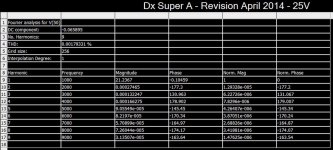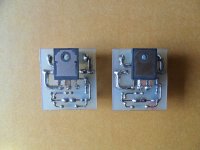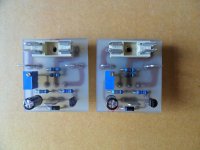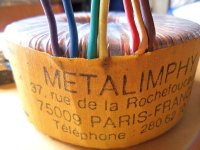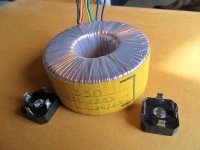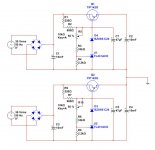Fourier have not became better.... in the reality it is worse
I had a better ratio in between second and third harmonics... at least in the simulator.
Well...this takes all parts as some standard... real world parts are never that way....so...this is just a "reference"..not something to take too much serious.
This is under 4 ohms load....60 watts RMS approximately.
Am i suggesting you to do that...to modify?.... no!...only if you need a small power amplifier due to your need or because of some precious speaker that cannot hold too much power.
regards,
Carlos
I had a better ratio in between second and third harmonics... at least in the simulator.
Well...this takes all parts as some standard... real world parts are never that way....so...this is just a "reference"..not something to take too much serious.
This is under 4 ohms load....60 watts RMS approximately.
Am i suggesting you to do that...to modify?.... no!...only if you need a small power amplifier due to your need or because of some precious speaker that cannot hold too much power.
regards,
Carlos
Attachments
Last edited:
Dear Carlos!
A Super DX gives me great pleasure to listen but I think my power supply does not put totally worth.
I have recovered an old transformer "Metalimphy (2x33V - 330VA)" and two diode bridge rectifier "Thomson BD37931" in my attic. The transformer was for 220V but the 240V which is now in France, which gives me 2X37.5V output.
I have created two controllers that give me exactly 40V.
When I shall have finished editing my amplifier I will say a few words about the new sound.
Regards!
A Super DX gives me great pleasure to listen but I think my power supply does not put totally worth.
I have recovered an old transformer "Metalimphy (2x33V - 330VA)" and two diode bridge rectifier "Thomson BD37931" in my attic. The transformer was for 220V but the 240V which is now in France, which gives me 2X37.5V output.
I have created two controllers that give me exactly 40V.
When I shall have finished editing my amplifier I will say a few words about the new sound.
Regards!
Attachments
This is interesting Carlos, so Dx Super A can work with lower power supply voltage to 25V? I think 60W is more than enough seems to be logic, I see what you mean "real world parts are never that way"
Regards
Juan
Regards
Juan
Hi Carlos,
How would you feel about powering it with one of these?
110V 220V 200W Digital Amplifier Power Supply Board with Switching | eBay
I'm very interested.
Thanks, Terry
How would you feel about powering it with one of these?
110V 220V 200W Digital Amplifier Power Supply Board with Switching | eBay
I'm very interested.
Thanks, Terry
Wow ! Terry, that might be a good alternative 😀 I check the images and the voltage is +28 - 0 - -28 V DC I guess it can be changed to 25V
Regards
Juan
Regards
Juan
Last edited:
I would feel scared Terry
These supplies have oscilators... and the frequency is a kind of frequency the Dx amplifier can amplify.
The signal does not come from the SMPS output...it is RFI (Radio Frequency Interference) that is generated in the connectors, component leads and copper tracks.... these parts behaves alike antenna...when electrical energy crosses these connectors then it is converted in electro magnetic energy that may travel into the air and be picked up into the power amplifier input.
This is something that should be tested using scope to see if some spurious signal is captured.
These supplies, if shielded inside metalic can, with the metalic can grounded, may work fine... also the distance (clearance) in between the SMPS and the amplifier may play a big roll in that stuff.
You should give it a try...but test it watching waveform in the oscilloscope.
I am preparing, together a friend, a SMPS..but it gonna be different...shielded...i gonna test it soon...but i will not share...try this one you have in Ebay.
regards,
Carlos
These supplies have oscilators... and the frequency is a kind of frequency the Dx amplifier can amplify.
The signal does not come from the SMPS output...it is RFI (Radio Frequency Interference) that is generated in the connectors, component leads and copper tracks.... these parts behaves alike antenna...when electrical energy crosses these connectors then it is converted in electro magnetic energy that may travel into the air and be picked up into the power amplifier input.
This is something that should be tested using scope to see if some spurious signal is captured.
These supplies, if shielded inside metalic can, with the metalic can grounded, may work fine... also the distance (clearance) in between the SMPS and the amplifier may play a big roll in that stuff.
You should give it a try...but test it watching waveform in the oscilloscope.
I am preparing, together a friend, a SMPS..but it gonna be different...shielded...i gonna test it soon...but i will not share...try this one you have in Ebay.
regards,
Carlos
TL431 Regulator
C1 and C2 are capacitors bracket (CO39).
I realized two Postif regulators for + / - 40V and ground.Do you've a schematic and layout to share of those controllers?
C1 and C2 are capacitors bracket (CO39).
Attachments
If the oscilator signal result picked up by the amplifier dear Terry
.... then you will not listen because it is above our audibility, but the circuit will amplify and the signal will be presented in the output and will be partially blocked by the output coil and zobel filter... the amplifier gonna be draining current and gonna overheat..the sound you may inject, the audio to be amplified gonna result undefined.
This can happens or not...all depends on the SMPS, the clearance in between and the presence or absence of shield.
regards,
Carlos
.... then you will not listen because it is above our audibility, but the circuit will amplify and the signal will be presented in the output and will be partially blocked by the output coil and zobel filter... the amplifier gonna be draining current and gonna overheat..the sound you may inject, the audio to be amplified gonna result undefined.
This can happens or not...all depends on the SMPS, the clearance in between and the presence or absence of shield.
regards,
Carlos
Yes!So you give each winding of a toroid his own controller?
Hey Carlos,
That is very interesting. I own that SMPS and have only tried it with a chip amp but was not happy with the sound. I haven't tried the chip amp with a conventional PSU. Now you have piqued my interest. I will have to try it and see. I just chalked it up to the chip amp but maybe it was the SMPS all along. Too bad because the SPMS is a nice little compact unit and of course much cheaper to buy.
Thanks, Terry
That is very interesting. I own that SMPS and have only tried it with a chip amp but was not happy with the sound. I haven't tried the chip amp with a conventional PSU. Now you have piqued my interest. I will have to try it and see. I just chalked it up to the chip amp but maybe it was the SMPS all along. Too bad because the SPMS is a nice little compact unit and of course much cheaper to buy.
Thanks, Terry
Yes, they are nice, compact, cheap, powerfull and reliable
These are the positive factors.... they generate interference, are noisy and regulation is not that interesting...the discharge of electrons of a bunch of capacitors is much more interesting in a millisecond than these supplies....also when you overdrive them, in a surge of consumption due to a peak of audio being reproduced, she can understand, the supply, as a short and switch down automatically due to the protection.
I would like to be clear, not to you that is skilled, but to beginners...if they intend to reduce power using 25/28 volts supplies, then they should search for soft moving speakers...these one you can move with a breath of your own air....the ones have long range into the compliance....when the diafragm moves a lot inwards and outwards... the ones are for 30 watts only..the ones have small magnet, soft surrounding foam as suspension..the ones have soft spiders..the ones will reach the end of it's travel with a 9V battery plugged into the terminals...this is what must be made...otherwise you will not have bass because high power speakers are hard to move and need much more volts and current (power) to move till them reach the maximum excursion of diafragm movement.
A flat speaker (no one is that way) will sound with low bass due to imbalance and mismatch of power related a ratio different than one when we think in "speaker versus power amplifier specifications".
The one to search to have a good suggestion of speakers is Nelson Pass, because his amplifiers (majority of them) are not that powerful due to inefficiency of Class A....so...he may have selected brand and models that are good to go together his amplifiers...he is the man.
To the beginners..... that 100 watt monster speaker will sound awfull with an amplifier that is powered by 25 plus 25 volts, and do not matter what kind of speaker it is, the brand, how much have costed and your believe that it is magnificent...it is not!...because made to handle 100 watts...cannot sound perfect with only 30 watts.
If your speaker can hold even higher power...as 200, 300, 400 or more watts...then it will become worse and worse...you will listen mids and treble only.
regards,
Carlos
These are the positive factors.... they generate interference, are noisy and regulation is not that interesting...the discharge of electrons of a bunch of capacitors is much more interesting in a millisecond than these supplies....also when you overdrive them, in a surge of consumption due to a peak of audio being reproduced, she can understand, the supply, as a short and switch down automatically due to the protection.
I would like to be clear, not to you that is skilled, but to beginners...if they intend to reduce power using 25/28 volts supplies, then they should search for soft moving speakers...these one you can move with a breath of your own air....the ones have long range into the compliance....when the diafragm moves a lot inwards and outwards... the ones are for 30 watts only..the ones have small magnet, soft surrounding foam as suspension..the ones have soft spiders..the ones will reach the end of it's travel with a 9V battery plugged into the terminals...this is what must be made...otherwise you will not have bass because high power speakers are hard to move and need much more volts and current (power) to move till them reach the maximum excursion of diafragm movement.
A flat speaker (no one is that way) will sound with low bass due to imbalance and mismatch of power related a ratio different than one when we think in "speaker versus power amplifier specifications".
The one to search to have a good suggestion of speakers is Nelson Pass, because his amplifiers (majority of them) are not that powerful due to inefficiency of Class A....so...he may have selected brand and models that are good to go together his amplifiers...he is the man.
To the beginners..... that 100 watt monster speaker will sound awfull with an amplifier that is powered by 25 plus 25 volts, and do not matter what kind of speaker it is, the brand, how much have costed and your believe that it is magnificent...it is not!...because made to handle 100 watts...cannot sound perfect with only 30 watts.
If your speaker can hold even higher power...as 200, 300, 400 or more watts...then it will become worse and worse...you will listen mids and treble only.
regards,
Carlos
Last edited:
or,
use a high efficiency speaker.
Typically >90dB/W @ 1m
If you can afford >94dB/W @ 1m, then go that route.
use a high efficiency speaker.
Typically >90dB/W @ 1m
If you can afford >94dB/W @ 1m, then go that route.
I have lost an entire text because of windows key hitted in my keyboard
I felt myself lazy to post the whole thing once again...then i decide to make a video...this is the first... about speaker efficiency...the second about SMPS will follow:
https://www.youtube.com/watch?v=k6kucgvwlg0
regards,
Carlos
I felt myself lazy to post the whole thing once again...then i decide to make a video...this is the first... about speaker efficiency...the second about SMPS will follow:
https://www.youtube.com/watch?v=k6kucgvwlg0
regards,
Carlos
About the SMPS .... a video explains... a little.
What i think about it.... my fears.... i do not suggest any SMPS since i have not tested the particular model people intend to use.
It can harm the audio amplifier audio reproduction due to interferences (RFI)
https://www.youtube.com/watch?v=4wLo7UirfIk
regards,
Carlos
What i think about it.... my fears.... i do not suggest any SMPS since i have not tested the particular model people intend to use.
It can harm the audio amplifier audio reproduction due to interferences (RFI)
https://www.youtube.com/watch?v=4wLo7UirfIk
regards,
Carlos
Input capacitor!
dear Carlos!
I have changed my DX Super A with a few improvements you suggested.
A question:
For the input capacitor of 1uF (I do not want remove this) a second in parallel 1uF give better results or it is not necessary?
thank you and regards!
dear Carlos!
I have changed my DX Super A with a few improvements you suggested.
A question:
For the input capacitor of 1uF (I do not want remove this) a second in parallel 1uF give better results or it is not necessary?
thank you and regards!
Not necessary.... with 2uf you will have sounds
that you cannot listen being reproduced...waste of power only.
regards,
Carlos
that you cannot listen being reproduced...waste of power only.
regards,
Carlos
After our discussion about using an SMPS for the power supply, I tested my Fetzilla which I had set up for use with an SMPS. This one one to be exact. The Fetzilla sounds very good with the SMPS but when I A/B'd it against other amps it seemed a little weak in the bass. So then I switched out the SMPS with a transformer and cap multiplier and found that the bass was greatly improved. Going to need some more investigating
Thanks, Terry
Thanks, Terry
This is all fun...enjoy!
We are developing a Kraftwerk - Dx power supply (SMPS)🙂
https://www.youtube.com/watch?v=d0Y8XWd_akA
regards,
Carlos
We are developing a Kraftwerk - Dx power supply (SMPS)🙂
https://www.youtube.com/watch?v=d0Y8XWd_akA
regards,
Carlos
- Home
- Amplifiers
- Solid State
- Dx Blame ST together Dx Super A
